In the past few years, I have been dedicated to improving my overall health. Unfortunately, although we are living longer, preventable chronic diseases are causing poor health in our later years.
We are the biggest drivers of our own health and our daily habits are the single most important factor keeping us healthy. Our future doesn’t need to be poor health caused by chronic disease like heart disease and Type 2 diabetes.
Throughout this series of posts, I will be sharing my insights on how I’m now living a healthier lifestyle. One key lesson that I have learned is that it is never too late to make positive changes. By taking small steps, we can gradually achieve a healthier lifestyle.
In this post, I share how I modified my diet to reach my goal of eating a healthy, balanced diet and achieving a healthier weight.
Healthier Food, Nutrition and Weight
My journey towards a healthier lifestyle began by acknowledging that years of fluctuating weight required me to gain a better understanding of what a well-balanced diet entails and how to attain a consistently healthier weight.
I have learned from every setback, analyzing what worked and where I made mistakes. I realized that to develop a balanced food plan that aligned with my goals, I needed the help of a professional dietitian. With so much conflicting information, I needed someone to help me make sense of it all and eliminate any confusion.
I have consulted two dietitians who had different approaches. The first dietitian focused on serving sizes, measured in cups and grams, and the recommended number of daily serves per food group. On the other hand, my current dietitian uses a science-based approach, and we use the Easy Diet Diary App to guide any necessary adjustments.
I had more specific goals working with my current dietitian:
- I want to lower my total and LDL cholesterol levels through improving my diet and attain a healthier weight – if possible.
- I want to achieve a healthy and sustainable weight by following a balanced diet. In the past, I struggled with unhealthy weight loss methods because I didn’t fully understand what a balanced diet entails.
Reducing cholesterol
It is possible for certain individuals to lower their cholesterol levels through modifications in their lifestyle. To achieve this, I have personally made certain dietary changes which I will detail below. Additionally, it is crucial to increase physical activity, which I will discuss in a future post.
Read Food Labels
An important step for deciding if a food is a healthy choice was learning how to read the food label.
My current dietitian explained what to look for on a food label and how I needed to check the saturated fat, sugar, sodium and calcium information in the per 100g column to decide if a food was healthy.

Reduce Saturated fats
Before, I was aware that cutting down on saturated fats can lower cholesterol levels. However, I was not aware that switching to low-fat alternatives like low-fat cheeses and low-fat cream might not help as these products are still too high in saturated fats. To maintain a healthy diet, I should aim to consume less than 3 grams of saturated fats per 100 grams. Ideal is less than 1.5 grams per 100 grams.
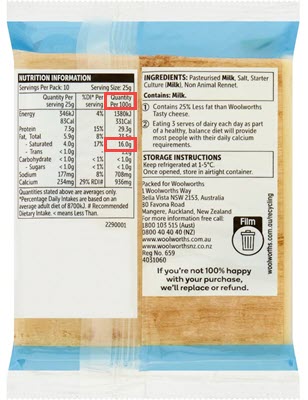
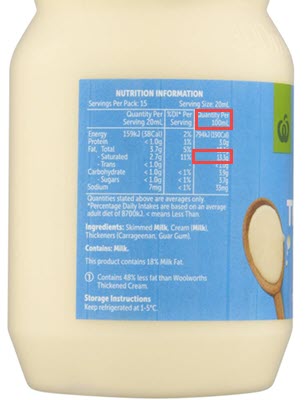
I was also caught out by coconut and light coconut milk which are high in saturated fat.
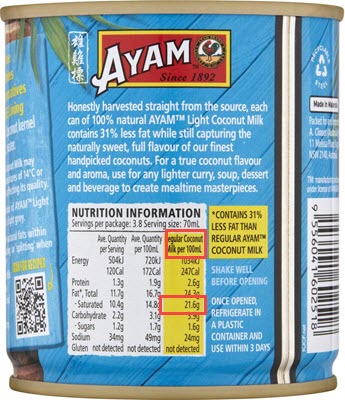
A key lesson has been learning how to read ingredient labels – keeping the total fat and saturated fats to within the best choice or okay sometimes range per 100 grams.
| Best Choice | Okay sometimes | Too High | |
| Total Fat | < 3 grams | 3-10 grams | > 10 grams |
| Saturated fat | < 1.5 grams | < 3 grams | > 3 grams |
Initially, I aimed to consume less than 15 grams of saturated fats daily. However, I have now lowered my target to less than 10 grams per day. Although I had been successful in losing weight, my blood test results revealed no improvement in my total cholesterol and LDL cholesterol levels.
I track my dietary goals using the Easy Diet Diary app. The app displays the daily data at the top, and by clicking on the saturated fats number, I can view the foods that contributed the most to my saturated fat intake.

The Easy Diet Diary App is an app developed in Australia, specifically designed for dietitians to use with their clients. MyFitnessPal also offers data for monitoring, but it’s important to be cautious because data entered by community members may not be accurate. This is not a concern with the Easy Diet Diary App.
Increase Fibre Intake
Consuming more soluble fibre can lower the absorption of cholesterol in the bloodstream and prolong feelings of fullness by slowing down digestion. Women should aim for a daily intake of 25-30 grams of fibre, while men should aim for 30 grams.
I used to consume only 10-15 grams of fibre per day, which is below the recommended daily intake. My initial goal was to reach 25-30 grams per day. Although I had been successful in losing weight, my blood test results revealed no improvement in my total cholesterol and LDL cholesterol levels. Research suggests that consuming 10 grams of soluble fibre per day can help lower cholesterol. To achieve this, I have increased my daily fibre intake to around 40 grams per day, with a focus on foods that are high in soluble fibre. This should help me reach my goal of 10 grams of soluble fibre per day.
The Easy Diet Diary app displays the daily data at the top, and by clicking on the fibre number, I can view the foods that contributed the most to my fibre intake.
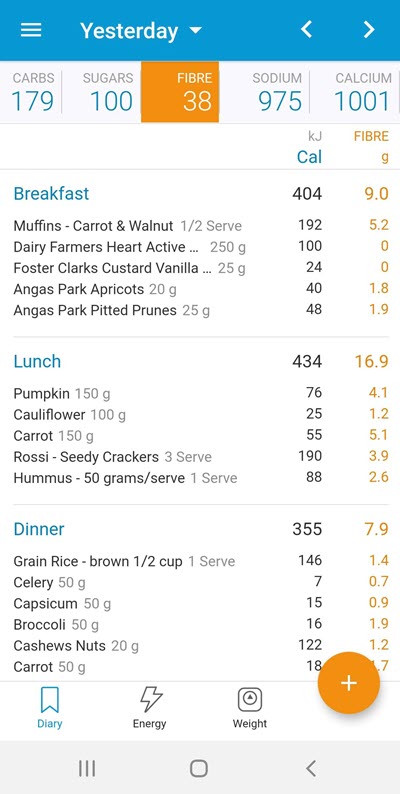
Consume Plant Sterols
Consuming 2 to 3 grams of plant sterol-enriched foods has been shown to lower LDL cholesterol by around 10 %.
| Product | Serving size |
|---|---|
| Sanitarium Cholesterol Lowering Weet-bix | 2 weet-bix |
| Carman’s Cholesterol Lowering Australian Oats | 50 grams |
| Carman’s Cholesterol Lowering Porridge Sachets | 40 grams |
| Heartactive Milk | 2x 250 ml |
| Pro-Active Margarine | 20 grams |
Since being diagnosed with osteopenia after breaking my leg in March, I have incorporated two glasses of 250 ml of Heartactive milk into my diet. Osteopenia refers to a lower-than-normal bone density. The addition of Heartactive milk to my diet helps me meet my calcium requirements while also providing plant sterols that assist in reducing LDL cholesterol.
Balanced Diet
In order to achieve a healthy and sustainable weight, I had to learn what a balanced diet looks like specifically for me.
Protein
Protein is essential for promoting cell growth, repairing tissues, and producing substances that protect against infections. Consuming more protein can increase feelings of fullness and decrease overall food intake.
To improve my bone density because of my osteopenia, it’s recommended that I consume 1.3 grams of protein per kilogram of body weight per day. This means I should aim to eat approximately 97.5 grams of protein daily, which is only possible with a maintenance diet. If I reduce my calorie intake below maintenance for weight loss, I won’t be able to reach my recommended protein intake. Alternatively, I can increase my exercise while consuming slightly more calories to achieve gradual weight loss.
Calcium
Throughout most of my life, I have had a low daily intake of calcium due to my infrequent consumption of milk, cheese, or yogurt. This has contributed to my osteopenia, which means my bone density is lower than normal.
I now achieve the recommended dietary Calcium intake for women over 51 of over 1,300 mg/day by consuming two glasses of 250 ml of Heartactive milk and taking a Centrum for Women 50+ multivitamin each day.
Vitamins
I share my food data with my dietitian through the Easy Diet Diary app. According to the analysis, it isn’t possible for me to attain the recommended dietary intake of vitamins through food while following a weight loss diet. Therefore, I take a daily Centrum for Women 50+ multivitamin to supplement my nutrients.
Gut Health
The most significant adjustment I’ve made is due to my friend and dietitian’s advice on the importance of gut health. Consequently, I have adopted a plant diversity diet and limit my meat intake to primarily fish or chicken.
It has been scientifically proven that the food we consume plays a significant role in determining the diversity and composition of our gut microbes. Studies indicate that consuming a wider variety of plants helps in nourishing the beneficial bacteria in our gut. Individuals who incorporate more than 30 different types of plants in their weekly diet exhibit a higher diversity in their gut microbiome, leading to better physical and mental health.
Fibre is the backbone of a plant diversity diet. Humans can’t digest fibre and our gut microbes digest fibre for us. Fibre helps lower cholesterol, reduce blood sugar spikes and is broken down by gut microbes to produce beneficial compounds.
The principles of a plant diversity diet are:
- Eat mostly plants.
- Aim for 30 different plants a week by incorporating a diversity of wholegrains, fruits, vegetables, nuts and seeds, legumes (beans, lentils, chickpeas, tofu), herbs and spices.
- Choose whole and natural where possible rather than processed food. Limit ultra-processed food including ultra-processed vegan food.
- Embrace legumes – incorporate legumes (beans, lentils, chickpeas, tofu) into meals as much as possible. Cost effective, nutrient dense.
- Add fermented foods.
Simple hacks for increasing plant diversity:
- Buy pre-mixed combinations of salads. For example, I normally eat a salad daily so if I ate the following three pre-mixed salads in a week I would achieve 10 plant points (points are given to each different type of plant):
- Woolworths Asian Style Salad Kit contains shredded wombok, cabbage, carrot, corn and mizuna leaves
- Woolworths Crunchy Noodle Slaw has red, white cabbage, carrot, celery and spring onion
- Woolworths Korean Crunch Salad Kit contains shredded wombok, red cabbage, spring onion, daikon, carrot, mizuna and spinach.
- Add fruit, nuts, seeds to breakfast, salads and roasted vegetables.
- Incorporate legumes (beans, lentils, chickpeas, tofu) into meals as much as possible. Increase diversity by using Four bean mixes or using different legumes each day (I freeze my left over canned beans).
- Increase diversity by using different wholegrains such as rolled oats, brown rice, red rice, black rice, freekah, quinoa, oat flour, spelt flour, rice flour.
Below are the books I recommend for learning more about gut health and a plant diversity diet:
Fibre Fuelled
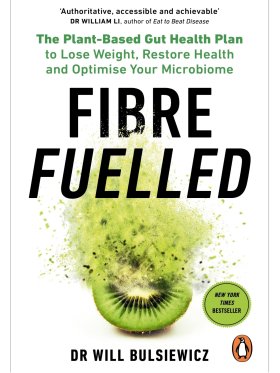
Fibre Fuelled is the book I recommend if you are into reading detailed scientific information like me. It provides comprehensive evidence based information on gut health science and the impact of a plant diversity diet on our gut health. It is written by gastroenterologist Dr Will Bulsiwicz to help his patients.
I don’t recommend Fibre Fuelled, or the Fibre Fuelled Cookbook, plant diversity menu program or recipes.
Eat More, Live Well
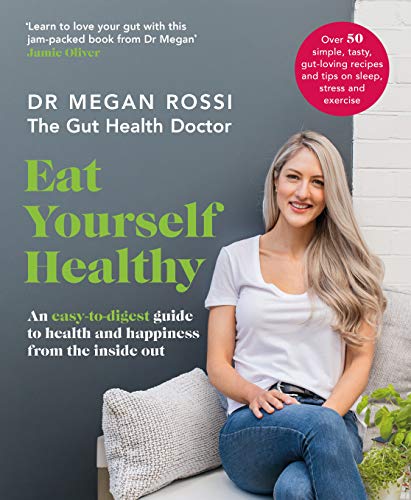
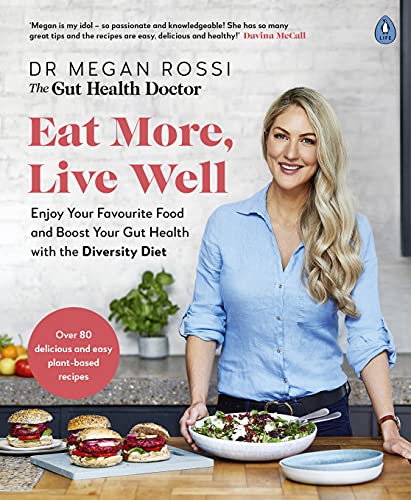
Dr. Megan Rossi is a dietitian and research scientist who holds a PhD in gut health. Her books offer practical and straightforward guidance, along with delicious recipes, for those interested in plant-based eating and adopting a diverse plant diet. These books also provide a simplified explanation of the plant diversity diet for those who may not be as interested in the in-depth scientific information presented in “Fibre Fuelled“.
As I transitioned from a Western Diet to a plant diversity diet, I had to learn new cooking skills and become accustomed to different tastes. Dr. Megan Rossi’s recipes have been a valuable resource for me, providing balanced and nutritious meals that have helped me develop my culinary abilities. Her recipes always turn out well and have inspired me to experiment with new dishes. As a passionate cook with an extensive cookbook collection, I often turn to Dr. Rossi’s recipes for inspiration.
- Eat Yourself Healthy (2019) sold as “How to Eat More Plants” in USA and Canada.
- Eat More, Live Well (2022)
Here are few of our favorite recipes from her website to try:
- Spinach and Ricotta Stuffed Pasta – I substitute low fat creamed cottage cheese for the ricotta and don’t add the feta to reduce the saturated fats and add juice from half a lemon and 1/4 teaspoon of nutmeg for flavor.
- Thai Inspired Fish cakes
- Banana, Fig and Zucchini loaf
My Progress
I have been seeing my dietitian since January 2022, and I am pleased with my progress. I have managed to lower my cholesterol and LDL cholesterol levels by making dietary changes such as reducing saturated fat, increasing fiber, and incorporating plant sterols.
| Dec, 21 | Sept, 22 | Feb, 23 | May, 23 | |
| Cholesterol | 5.9 | 6.1 | 5.5 | 4.9 |
| LDL Cholesterol | 4.2 | 4.0 | 3.6 | 3.0 |
| HDL Cholesterol | 1.3 | 1.6 | 1.5 | 1.5 |
| Triglyceride | 0.9 | 1.1 | 0.9 | 0.9 |
| Chol/HDL Ratio | 4.2 | 3.8 | 3.7 | 3.3 |
| Non HDL Cholesterol | 4.2 | 4.5 | 4.0 | 3.4 |
Over time, I’ve managed to reach a healthier weight by gradually reducing my weight while maintaining a well-balanced diet. I don’t like to disclose how much weight I’ve shed because my main focus is on consuming nutritious and balanced meals and achieving a healthier weight.
Below is what my current dietary analysis looks like excluding the Centrum for Women 50+ multivitamin:
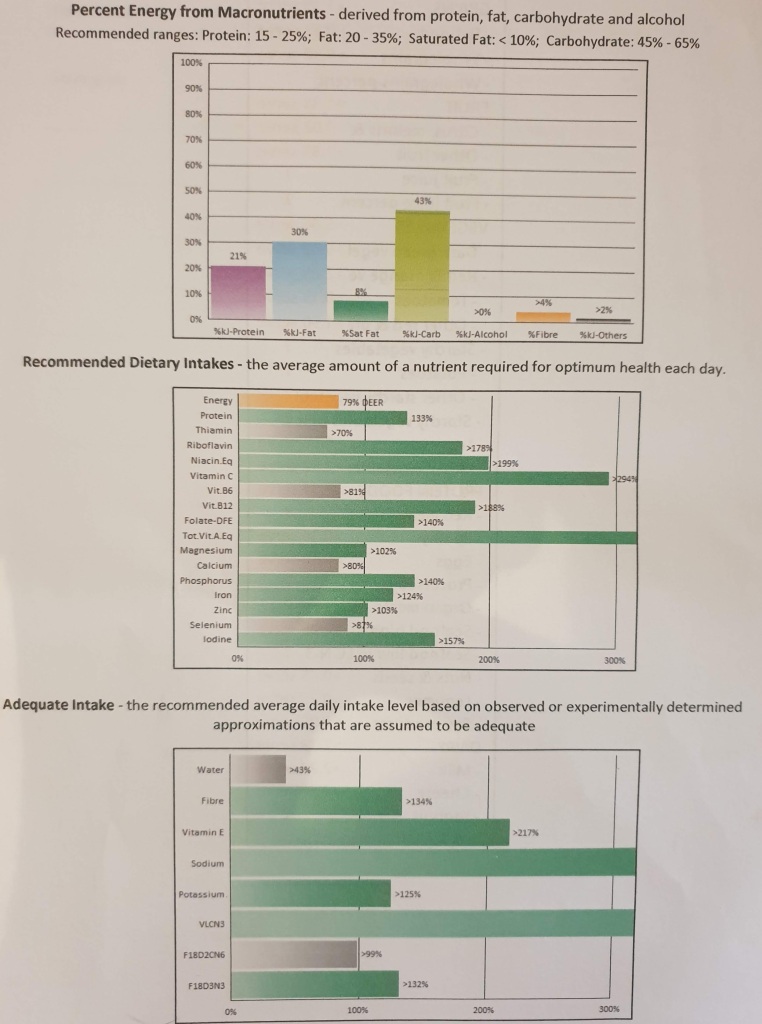
And here is a breakdown based on food groups:
| Food Group | My current number of serves per food group | Recommended number of serves for maintenance: Women 51-70 years |
|---|---|---|
| GRAINS | >1.19 | 4 |
| Refined Grains | >0.82 | |
| Wholegrains | >0.38 | |
| FRUIT | >1.85 | 2 |
| VEGETABLES | >5.86 | 5 |
| Dark green vegetables | >0.32 | |
| Red & orange vegetables | >2.05 | |
| Tomatoes | >0.15 | |
| Other red & orange vegetables | >1.9 | |
| Starchy Vegetables | 0 | |
| Legumes | >1.18 | |
| Other vegetables | >2.32 | |
| PROTEIN FOODS | >2.31 | 2 |
| Red Meat | 0 | |
| Poultry | >0.36 | |
| Eggs | >0.44 | |
| Seafood (oily) | >0.25 | |
| Seafood (non oily) | 0 | |
| Nuts & Seeds | >0.45 | |
| Legumes | >0.73 | |
| Soy Products (tofu) | >0.09 | |
| DAIRY | >2.38 | 4 |
| Milk | >2.20 | |
| Cheese | >0.18 |
Final Thoughts
One important lesson I have learned is the importance of tailoring a balanced and healthy diet to fit your individual needs. In my own diet, I prioritize reducing my intake of saturated fats, increasing my fiber consumption, incorporating plant sterols, and meeting my dietary calcium requirements in order to lower my cholesterol levels, decrease LDL cholesterol, and improve my bone density.
My husband is a healthier weight but has a family history of high blood pressure and type 2 diabetes. Adding iodized table salt back into my cooking increased his blood pressure – our doctor wasn’t happy. He has had to reduce his consumption of fruits and sugar because his fasting glucose levels are high. This is not a concern for me.
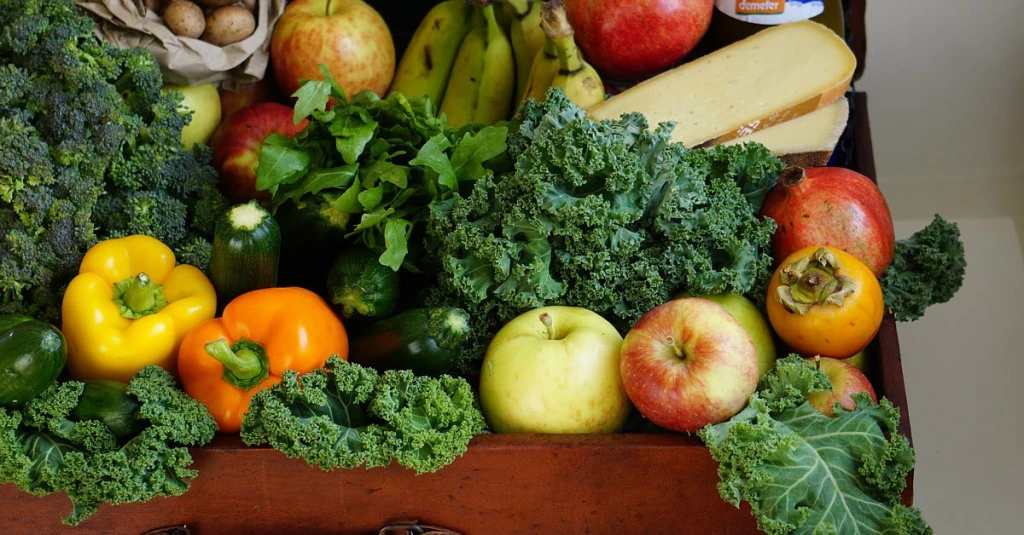



Leave a comment